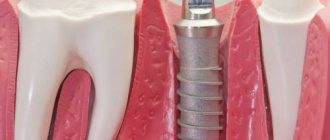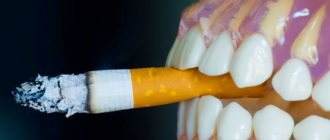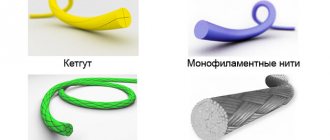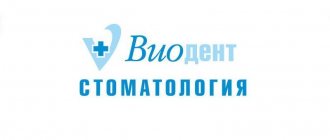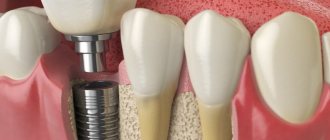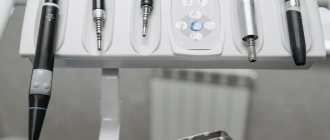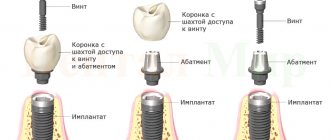The seventh teeth (second molars according to the dental classification) are located in hard-to-reach places. They are often lost due to poor hygiene. Also in this area there are high chewing loads, which accelerates destruction. To restore missing teeth, implants and dentures are used. When removing sevens, a terminal defect often occurs, since wisdom teeth are often removed at the eruption stage or do not erupt at all. In such cases, implantation is the best solution, since it guarantees reliable fixation, restoration of chewing function, and long service life.
Causes and consequences of losing the seventh teeth
Tooth loss usually occurs due to chronic diseases. Sevens are at risk - they are subject to heavy loads when chewing food, and their location does not allow for high-quality hygiene at home. Together, these factors lead to the rapid development of caries, pulpitis and crown destruction. Following the crown, inflammation moves to the root, periodontitis occurs, the formation of granulomas and cysts. If not treated in a timely manner, the inflammatory process spreads over large areas, which leads to the removal of the source of infection. Other reasons:
- periodontitis;
- jaw injuries;
- bone atrophy due to age-related changes;
- congenital anomalies.
The loss of even one unit of dentition leads to the following consequences:
- malocclusion - voids in the dentition lead to a displacement of neighbors towards the missing unit, while the jaws will no longer close as tightly as before;
- diseases of neighboring teeth - when tilted towards the defect, the necks become exposed, sensitivity and inflammation occur;
- diseases of the digestive system - food is not chewed properly, pathologies of the stomach and pancreas develop;
- bone atrophy - due to root loss, the load on the jaw decreases and it becomes thinner;
- change in appearance - tired appearance due to sunken cheeks and wrinkles.
Possible problems
Permanent teeth have just appeared, but this does not mean that there will not immediately be any problems associated with them. Parents should be aware of possible dental problems:
- lack of molars;
- pain in the molar area;
- crooked position of molars;
- molars fall out;
- injuries.
For any of these problems, it is important to contact a specialist in time to receive qualified help.
Recovery methods
You can restore sevens by:
- fixation of a dental bridge;
- installation of a removable denture;
- implantation
A bridge in the absence of one tooth consists of three crowns. The outer ones are fixed on the supporting teeth, and the middle one compensates for the lost unit. Since the seventh tooth is usually the end tooth, there is nothing to attach the permanent bridge to. In this case, removable structures are used.
Removable dentures are fixed on the teeth on one side, and glued to the gums with a special gel on the other. This is an inexpensive option, but unreliable - the fixation of the prosthesis is unstable and does not provide functional qualities.
Implants completely imitate the structure of the tooth and are the best solution to the problem. A titanium root is screwed deep into the jaw, and a crown is placed on top. Neighboring units of the dentition are not involved in any way. An artificial tooth is no different from a natural one and takes the same chewing loads.
- Dental bridge
- Removable denture
- Implantation
Deviations from the norm
After the mother has become familiar with the necessary sequence of growth of the child’s teeth, it is necessary to exclude the presence of deviations. There are cases where tooth growth is delayed or does not occur according to plan, and this is the norm. But sometimes doctors can say that deviations are pathological. How to determine what is normal and what is not?
Early appearance of teeth
If you think that your baby teethed very early, then you should think about the specificity of the hereditary predisposition or thyroid disease.
A rather rare but existing situation is when a baby is born with an existing incisor. In medical practice, such a manifestation occurs very rarely; it indicates a hormonal imbalance in the body. If there is a defect, it is more advisable to visit an endocrinologist to receive qualified treatment.
Late appearance of teeth
Young mothers sound the alarm when the child’s first tooth makes itself felt only at the end of the first year. However, medical specialists do not always consider this course pathological. If children are missing at least one tooth per year, it is more advisable to visit a dentist and pediatrician.
An interval between tooth formation lasting more than 60 days is considered abnormal. In this case, the defect is due to a reduced calcium content, poor absorption of vitamin D and other pathologies.
Implantation stages
Implant installation is carried out using the classical method. Includes stages:
Preparatory
Examination and sanitation of the oral cavity, assessment of the condition of bone tissue, examinations, including x-rays and consultation with a therapist. It takes from one to two days (if no contraindications are identified and no sanitation of the oral cavity is required) to a couple of months (if obstacles to the operation are found).
Bone tissue augmentation
Optional step. It is necessary for long-term absence of a tooth, when the jaw at the site of the defect is atrophied and needs to be restored. The material is planted into the alveolar process and waited until it fuses with the bone. The operation itself lasts 2-3 hours, but the recovery period takes up to six months. In cases of minor bone loss, osteoplasty is performed simultaneously with the installation of an artificial root.
Implant installation
The gum is surgically removed and a hole is made in the bone for an artificial root. After installing the implant, a plug is attached on top, and the mucous membrane is sutured. Engraftment up to 6 months.
Installation of the healing abutment
The gums are opened and a former is placed on the titanium root for 10-14 days to create the contours of the gums for the future crown.
Fixation of permanent prosthesis
The former is replaced with an abutment (an adapter between the crown and the implant). The crown is installed using previously taken impressions.
Where to put baby teeth after they fall out?
The first tooth can be kept as a souvenir or given to the child to put in a box with children's valuables. If sentimentality is not accepted in your family, then the tooth can be thrown out.
In many families, the tooth is placed under the pillow to be taken away in exchange for a coin or small treat by the Tooth Fairy. This character came to us from the West. The fairy builds a castle from children's teeth in which good dreams are born.
But there is also a domestic tradition - to give a lost tooth to a mouse, which can also thank you with a gift. Previously, the tooth was thrown underground or hidden behind the stove with the words “Here, mouse, a bast tooth! Give me a bone one, mouse!” Now this story is more suitable for residents of private houses. It's up to you to decide whether it's worth chasing a mouse into an apartment on the 20th floor, even if it's a fabulous one. But you can take absolutely any magical character that your child likes and come up with a story about where and why the baby’s tooth will end up.
Interesting fact: baby teeth contain both stem and progenitor cells. Scientists believe that in the future, with the development of science and technology, baby teeth can be used for the benefit of their owners, for example, to treat serious diseases. But in order to preserve the cells in the tooth, special storage conditions are required, which, unfortunately, cannot be created at home.
Is it possible to use express methods for sevens?
Express implantation can be performed in two ways.
Option 1 - place a crown right away
Implantation Immediate Load - instant loading of a titanium root with a crown. In 3-7 days, the patient completes the full course of treatment and receives a new tooth. But this protocol is not suitable for sevens. Usually there is not enough bone tissue in case of loss of the last tooth. And implantation with an immediate load is carried out only when there is a sufficient amount of bone. In case of atrophy, rapid loading does not provide reliable fixation of the titanium root; it cannot be guaranteed that the implants will last the entire period promised by the manufacturer.
Even in the case of ideal conditions with a sufficient amount of bone tissue, it is not recommended to immediately load the seven implant with a crown. The second molar is actively involved in the chewing process; displacement during chewing is possible.
Option 2 - place an implant immediately after tooth extraction
The implant is installed in the hole immediately after the seven is removed. In this case, the healing stage after extraction is skipped, which saves the patient 4-5 months. For 7 teeth, this method is allowed only if there is an adequate amount of bone tissue, planned rather than emergency tooth extraction, the absence of cysts and granulomas on the root, and gentle extraction without damaging the alveolar process.
Features of teething
Teething can be painless, without disturbing the baby’s well-being or changing his behavior. However, in most cases, this process is accompanied by hyperemia, fever, refusal to eat and many other symptoms.
At this stage of child development, all dads, and especially moms, need to be patient and prepare themselves for the fact that the period of teething may be accompanied by severe symptoms.
Modern parents are very worried about this problem, so they try to carefully read the necessary literature, learn from the experience of relatives, in order to prepare for the appearance of the first incisor. More often, mothers find plans that provide the required number of teeth at a given period of age, and if there are no expected results within the specified period, they begin to panic.
Is it possible to know in advance which tooth will make itself known first? In what order do children's teeth appear? It is quite difficult to answer questions with accuracy, since each organism is special and its development occurs in its own way.
Price
The cost of installing an implant in our Center is standard. Pricing is formed on a turnkey basis. There are several ready-made treatment options. For example, using Nobel Biocare PMC implants, restoring a seven is 20 thousand cheaper than installing a Nobel Biocare Conical Parallel CC. The first ones are used for weak bones, the second ones - of the new generation, for strong ones.
The operation takes place in two stages. At the first, the price includes the procedure itself, the implant and plug, pain relief, consumables, postoperative X-ray examination and CT scan after eight weeks. The application and removal of sutures are also taken into account when determining the cost.
At the second surgical stage, the price list includes painkillers, antiseptics, opening and removal of implant plugs, fixation of gum formers, and consumables.
In the “implantation” case, the cost of surgical treatment does not include crowns. The price depends on the manufacturing method and type of fixation.
Our Center has its own laboratory, where only all-ceramic crowns are manufactured using the Zirkonzahn Schule method. You can order production at the Swiss PROCERA plant, but you will have to wait longer.
The cost of the case does not include sanitation, sinus lift, osteoplasty and temporary prostheses until the implants are healed.
How to count teeth in an adult
The calculation depends on the scheme used. Detailed table with values for adults.
| Name | Universal | American | Haderupa | Zsigmondy-Palmer | Viola |
| 3rd century n. molar | 1 | V.p. M3 | 8+ | 8┘ | 18 |
| 2nd century n. molar | 2 | V.p. M2 | 7+ | 7 ┘ | 17 |
| 1st century n. molar | 3 | V. p. M1 | 6+ | 6┘ | 16 |
| 2nd century n. premolar | 4 | V. p. P2 | 5+ | 5┘ | 15 |
| 1st century n. premolar | 5 | V. p. P1 | 4+ | 4┘ | 14 |
| V. p. fang | 6 | V.p.C | 3+ | 3┘ | 13 |
| V. p. lateral incisor | 7 | V. p. I2 | 2+ | 2┘ | 12 |
| V. p. central incisor | 8 | V. p. I1 | 1+ | 1┘ | 11 |
| V. l. central incisor | 9 | V. p. I1 | +1 | 1└ | 21 |
| V. l. lateral incisor | 10 | V. l. I2 | +2 | 2└ | 22 |
| V. l. fang | 11 | V. l. C | +3 | 3└ | 23 |
| 1st century l. premolar | 12 | V. l. P1 | +4 | 4└ | 24 |
| 2nd century l. premolar | 13 | V. l. P2 | +5 | 5└ | 25 |
| 1st century l. molar | 14 | V. l. M1 | +6 | 6└ | 26 |
| 2nd century l. molar | 15 | V. l. M2 | +7 | 7└ | 27 |
| 3rd century l. molar | 16 | V. l. M3 | +8 | 8└ | 28 |
| 3 n. l. molar | 17 | N. l. M3 | -8 | 8┌ | 38 |
| 2 n. l. molar | 18 | N. l. M2 | -7 | 7┌ | 37 |
| 1 n. l. molar | 19 | N. l. M1 | -6 | 6┌ | 36 |
| 2 n. l. premolar | 20 | N. l. P2 | -5 | 5┌ | 35 |
| 1 n. l. premolar | 21 | N. l. P1 | -4 | 4┌ | 34 |
| N. l. fang | 22 | N. l. C | -3 | 3┌ | 33 |
| N. l. lateral incisor | 23 | N. l. I2 | -2 | 2┌ | 32 |
| N. l. central incisor | 24 | N. l. I1 | -1 | 1┌ | 31 |
| N.p. central incisor | 25 | N. item I1 | 1- | 1┐ | 41 |
| N.p. lateral incisor | 26 | N. item I2 | 2- | 2┐ | 42 |
| N. p. fang | 27 | N.p.C | 3- | 3┐ | 43 |
| 1 n. n. premolar | 28 | N. P1 | 4- | 4┐ | 44 |
| 2 n. n. premolar | 29 | N.p. P2 | 5- | 5┐ | 45 |
| 1 n. n. molar | 30 | N.p. M1 | 6- | 6┐ | 46 |
| 2 n. n. molar | 31 | N.p. M2 | 7- | 7┐ | 47 |
| 3 n. n. molar | 32 | N.p. M3 | 8- | 8┐ | 48 |
Abbreviations used in the table: c. p. – upper right, c. l. – top left, n. l. – lower left, n. p. – lower right.
Guarantees
The Center for Private Dentistry “Doctor Levin” has a guarantee program. The patient of the clinic will receive a guarantee for:
- implant;
- surgery;
- sinus lifting and osteoplasty;
- prosthetics.
Only Lifetime on Nobel Biocare issues a lifetime warranty on the implant; other companies usually provide 25 years.
The warranty provides a year of free service for implantation and two years for all types of treatment. The contract is valid subject to systematic medical examinations and proper care.
International Viola system
It is extremely simple and concise, so it quickly received international status. Each area in the mouth is assigned a number: lower right area -4, upper left area -2. The countdown starts from the conventionally designated center - the incisor, which is located in the middle.
In addition to the Viola system, there is a second one, which is called square-digital. Radical units are designated by Arabic numerals and numbers, and dairy units by Roman symbols. In the United States of America, it is common to use a universal letter scheme. There are different types of systems used in a patient's medical record.
